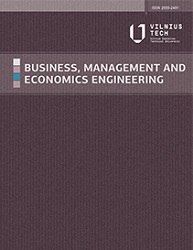Financial performance – determinants and interdependencies between measurement indicators
Financial performance – determinants and interdependencies between measurement indicators
Author(s): Mihaela Brîndușa Tudose, Valentina Diana Rusu, Silvia AvasilcăiSubject(s): Business Economy / Management, Financial Markets
Published by: Vilnius Gediminas Technical University
Keywords: financial performance; determinants; economic value-added; automotive industry;
Summary/Abstract: Purpose – the study has a dual purpose. First, to assess the impact of the most important determinants of financial performance, which have been measured through four generations of indicators. In addition, the study provides the first quantification of interdependencies between different financial performance measures: profit margin (PM), profit growth rate (PGR), return on assets (ROA), return on equity (ROE), and economic value added (EVA). Research methodology – the primary data was collected from the AMADEUS database. Empirical research was conducted on a relatively homogeneous sample from the automotive industry, using the panel data method for the period 2010–2019. Two models were tested. The first model highlights the relationships between performance measures and selected determinants. The second model highlights the relationship between the different performance measures and the determinants used in the first model. Findings – the determinants analysed have different influences on the selected performance measures. For example, in the first model, the results statistically significant indicated the following. The current ratio has a positive influence on ROA, but a negative one on ROE and EVA. Gearing has a negative influence on PM and ROA, but a positive one on EVA. The growth rate of sales has a positive influence on PM, but a negative one on ROA and EVA. The size of the company has a positive influence on three performance measures (PM, ROA, and EVA). Regarding the relationships between the different performance measures (second model), the research indicates that EVA is negatively influenced by PGR and ROA. In this model, the determinants analysed maintain their meaning and intensity of influences. Research limitations – the article has several limitations. The representativeness of the results is valuable only at the level of the researched industry. In addition, it should be noted that the analyses are focused only on financial performance, assessed by accounting measures. The authors are considering conducting comparative analyses at the level of fields/branches of activity to capture not only the impact of determinants on financial performance but also to assess organizational resilience. Practical implications – The research provides clues to managers and financial decision-makers to increase the financial performance of the companies they lead. Originality/value – the originality of the study lies in the presented methodological approach. Unlike previous research, which usually evaluated performance on only one indicator, this paper aims to assess the impact of the most important determinants on five performance measures. In addition, the analysis of the interdependencies between the different performance measures is another novelty of this research.
Journal: Business, Management and Economics Engineering
- Issue Year: 20/2022
- Issue No: 1
- Page Range: 119-138
- Page Count: 20
- Language: English

